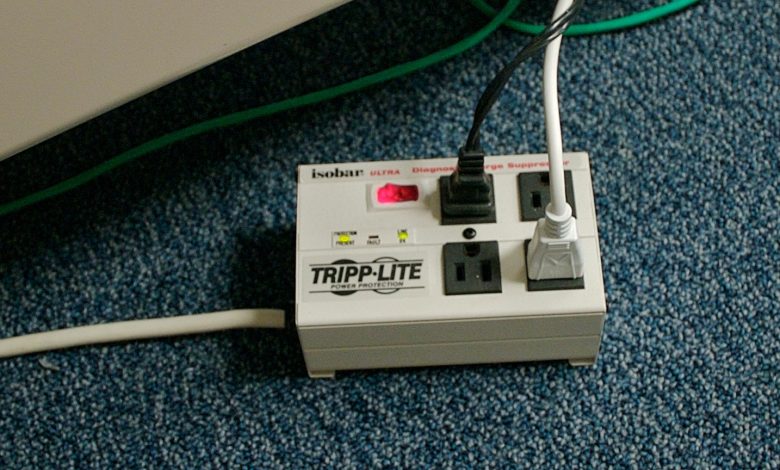
Power strips and surge protectors are two completely different things! Here’s what makes them different and why you need a reliable surge protector, and what a surge protector does.
Surge protectors and power strips can sometimes be confused, but they are two different technologies. Learning the difference is essential, as only one of them will protect your devices from power spikes! Let’s explore what a surge protector do with all other facts.
What Does A Surge Protector Do?
To understand how a surge protector works, we must first determine what protects your electronics from–an electrical surge.
The flow of electricity is similar to water flow through a pipe. In a pipe, water moves from one end to the other due to water pressure — water moves from high pressure to low pressure.
The electrical energy industry operates similarly, moving from areas with high electrical potential energy to areas with low electric potential energy. An electrical current is a flow of electricity from one end of a wire to another.
This electric potential energy is measured by voltage, precisely the difference in electrical potential energy. An electrical surge occurs when the voltage exceeds the norm for at least three nanoseconds.
The electricity will surge through the wire if the wire voltage is too high or if the difference in electric potential energy is too significant from one end to the other. The heat causes the wire to heat up; if it gets hot enough, it can burn the wire and render it useless.
The surge protector has only one job: detecting excessive voltage and diverting it into the grounding wire. All surge protectors come with a grounding pin (the third prong on the plug) and must be connected to a grounding outlet to function correctly.
When ought a power surge protector to be used?
Plugging lamps as well as other tiny, inexpensive devices, directly into a power outlet is possible. Surge suppressors, meanwhile, should be used with all oversized or more important items, as well as with appliances like pcs, printers, televisions, and refrigerators that require steady electricity.
Electrical Surges: What Are They?
Generally, people think lightning is the primary cause of electrical surges, but this isn’t the case.
Lightning can cause electrical surges, but it’s not as common as other causes. Buying a surge protector to save your electronics from a thunderstorm may not work in your favor.
A good surge protector can handle a surge caused by a distant thunderstorm. However, a lightning bolt will fry it if it is close or direct. Thus, unplugging your electronics provides the best protection against thunderstorms.
The most common cause of electrical surges is the operation of devices that need a lot of power. Depending on your home’s wiring, you may sometimes notice that your lights flicker when powerful devices, like your air conditioner, are on or off.
These devices consume a lot of electricity when switched on, which puts a lot of strain on the grid and can cause surges.
What happens if the transmission fluid runs out?
Without fluid, there would be no hold, preventing the gears from rotating and the car from moving. You may also need to consider significant repairs or even a complete transmission rebuild if your vehicle eventually reaches the stage where it runs out of the lubrication system.
Surge protectors: Are they necessary?
Because surges can happen at any time, you don’t need to worry about when to use a surge protector; use it constantly. The real question is what you should plug into the surge protector.
A surge protector isn’t necessary for your desk lamp or standing fan. Still, it is required for expensive electronic devices with microprocessors, such as computers, televisions, stereo systems, and media centers. A surge protector is essential for any electronic device that is expensive or electronic.
Consider this: if all the devices connected to your outlets were destroyed by an electrical surge, which loss would touch you the most? Make sure the devices are protected. Being safe is better than being sorry.
On an offbeat note, surge protectors can reduce cable clutter and make your electronic devices easier to organize. All the cables end up going to the same place, making it easier for you to handle them all neatly.
How to choose the Surge Protector?
Finding a suitable surge protector for you at a reasonable price can be challenging. But what makes a surge protector suitable? Why are some surge protectors more expensive than others? Should you pay attention to certain features?
Here are some things to look out for when buying a surge protector.
1. LED indicators
Surge protectors have a limited lifespan based on how hard they are used. Although surge protectors effectively divert surges, they can still suffer damage.
The most important feature is a light which indicates when the surge protector is active. The indicator light indicates that the surge protector is functioning correctly. What if the light is not working? It would be best if you had a new surge protector.
2. Rating UL.
For surge protection, suitable surge protectors have a UL rating issued by the independent Underwriter’s Laboratories, which tests the safety of electronic devices.
A surge protector that does not have a UL rating isn’t worth your time. Also, ensure the product is rated as a “transient voltage surge suppressor” since many UL-rated power strips do not contain surge protection.
3. The Clamping Voltage
A surge protector’s clamping voltage determines when to start redirecting excess electricity away from connected devices. In other words, a surge protector with a lower clamping voltage will trigger earlier, thus protecting your devices faster.
Any surge protector with a clamping voltage below 400 volts should be suitable for home use.
4. Power Rating
It surges the protector’s capacity to absorb energy. It renders the protector inoperable if the surge exceeds this maximum.
The higher the joule rating, the more energy that can be absorbed by the surge protector, so a higher joule rating indicates a longer product lifespan.
You need a surge protector rated at least 600 joules to protect your household adequately.
5. The Response Time
Response time refers to how quickly the surge protector detects an electrical surge. A lower value indicates a faster response. This way, less time is spent exposing plugged-in devices to surges, ensuring that they are better protected.
A surge protector with a response time of one nanosecond or faster is ideal.
Apart from this, if you are interested to know about cost to change transmission fluid then visit our Tech category.


